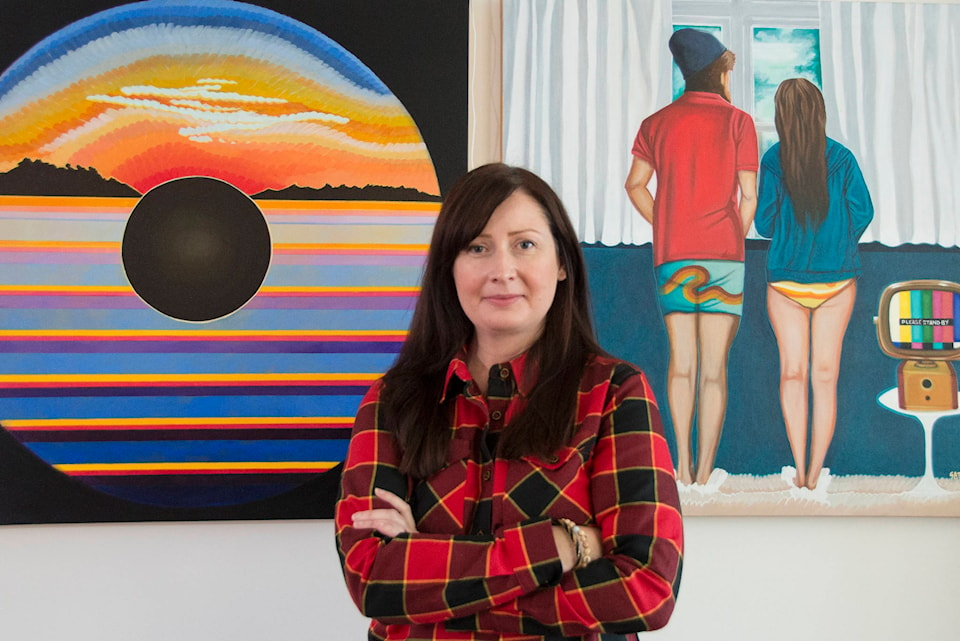When the pandemic hit, painter Brandy Saturley began to look inward. She maintained her signature pop realism style, but her focus shifted closer to home: the Salish Sea, her memories and her own desire for closeness.
Inside her North Saanich studio a collection of shells, small animal skulls and other found objects line a window sill. On the wall, a seal cub’s face is painted on a bed of a Canadian Club Whisky coasters. Her latest work rests on easels around the room, much of it a response to the pandemic.
Saturley, who grew up in Sooke, is known for her Canadiana-inspired acrylic paintings. Her vibrant Canadian art collection boasts landscapes, Tim Hortons cups and Canadian icons like Gord Downie and a hockey stick-holding Shania Twain. One painting depicts a Mi’kmaq performer and RCMP officer at the Vimy Ridge 100th anniversary; another portrays a Canadian veteran poised above a field of red poppies. One piece portrays a couple standing outside the Montreal Forum, posed in the style of Grant Wood’s 1930 painting American Gothic. In Saturley’s interpretation, the woman wears a hoodie and the man holds a hockey stick in place of a pitchfork.
Saturley coined the hashtag #IconicCanuck for her first public gallery exhibition and the name has followed her ever since as her Canadiana alter ego. Part of her fascination with the Canadian identity comes from growing up on Vancouver Island – separated from the rest of the country by ocean and often times, a completely different weather system.
While undoubtedly still Canadian, Saturley felt removed from many of the hallmarks of Canadian settler culture. Leading up to Canada 150 she began to travel the country, taking inspiration from people and landscapes – from Yellowknife to Montreal.
READ ALSO: Pandemic brings success to Indigenous artist carving COVID masks
“I feel that living on Vancouver Island, we’re not really part of that whole Canadiana stereotypical view. I feel like we’re our own little biosphere here,” she said. “I thought it would be really interesting to travel across Canada and see how much of these stereotypical Canadian things were actually things that people related to.”
But in 2020, Saturley’s world got much smaller. Like many, she began to consume the news daily, isolate and keep her distance from relatives.
“It was a year where I allowed myself to paint whatever I felt like I needed to paint,” she said. “Certainly, what influences you is what’s happening all around you, all the time, everything you hear and see and touch.”
On Canada Day she painted The Big Hug, depicting a group of Canadians embracing one another, an illustration of the physical closeness made impossible by COVID-19.
“For me, that was that need to hug and have connection, particularly having elderly parents that I couldn’t hug at the time,” she said.
Another painting depicts two people staring out a window while a TV displays the ‘Please Stand By’ message of a lost signal, seeming to represent longing or waiting. Her paintings Time in a Bubble and To the See are less literal, focusing instead on landscape, colour and concept, with Island views encapsulated in circles – freezing the serene, picturesque beauty of the West Coast in sunset-hued rings.
“I think that [Time in a Bubble], which was at the very beginning of COVID, for me, was sort of ‘here’s this perfect Vancouver Island life, I’m out paddling and there’s a sunset’ and it’s beautiful and it’s perfect but now it’s a bubble of a memory.
“I’m preserving it, so it’s something for me to meditate on…for the times that I’m feeling stressed or feeling like I can’t connect with people.”
Saturley felt it was important that her art continued to respond to society and culture through the pandemic.
“I just feel that internal need to say something about the time that we’re in. I mean, sometimes I make paintings that are just pretty paintings. But sometimes I make paintings that talk about subjects that are happening in the world,” she said. “I think both are important.”
READ ALSO: Victoria artist hopes painting will boost frontline worker morale
Do you have something to add to this story, or something else we should report on? Email: nina.grossman@blackpress.ca. Follow us on Instagram. Like us on Facebook and follow us on Twitter.
